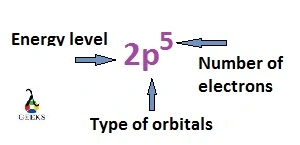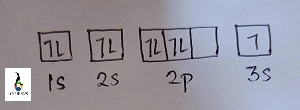Fluorine electron configuration is found to signify the arrangement of electrons in the atomic orbitals of Fluorine. Let us find the electron configuration of Fluorine below:
Fluorine is found to be the most electronegative element in the periodic table. It belongs to group 17 and period 2. The atomic number of a Fluorine atom is 9. The electronic arrangement in shell is made as per the atomic number. The shells are the representatives of different energy levels.
There are some specific rules that are Aufbau principle, Pauli’s expansion rule and Hund’s rule followed to represent the electron configuration of the atoms. In the case of Fluorine the followed rule and the diagram of the atomic orbital would be discussed throughout this article.
How to write Fluorine electron configuration?
In accordance with Aufbau principle, the step-by-step process of writing electron configuration is as follows:
- Step 1: Shell numbers are written in the first step.
- It has been identified that one Fluorine atom has 3 electron shell.
- The writing sequence of shell numbers would be 1, 2 and 3.
- Step 2: In the second step the orbitals are written after shell numbers.
- Fluorine atom has only s and p orbitals. According to Aufbau principle, the manner of writing orbitals is 1s, 2s, 2p, 3s, 3p and so on.
- Step 3: Next we have to put subscript with the orbitals name.
- Subscripts would refer to the number of electrons in each orbital.
- In first orbital that is 1s, 2 electrons are present in fluorine atom
- In 2s orbital, 2 electrons are present in the atom.
- In the next orbital 2p, 5 electrons are present in Fluorine atom
- Step 5: Writing the name of Noble gas is final step.
- At last the respective noble gas must be put in front of the whole electron configuration
- The writing as Fluorine completes through writing [He] for Helium.
Fluorine electron configuration diagram
Electron configuration diagram of Fluorine is imposing the fact that two ‘s’ orbitals of the atom are filled with maximum capacity of 2 electrons but the p orbital is not filled with complete 6 electrons, it has only 5 electrons.
The diagram is as follows:

Fluorine electron configuration notation
The notation of Fluorine’s electron configuration is found as
[He] 1s2 2s2 2p5
In the electron configuration of Fluorine the notation of electrons shells are used by general numbers such as 1, 2, and 3 and so on. The orbitals are denoted by alphabets s and p. The number of electrons that is 9 is divided in the orbitals as subscripts.

Fluorine unabbreviated electron configuration
Unabbreviated electron configuration is Fluorine is 1s2 2s2 2p5 which denotes that
- In 1s orbital there is 2 electron
- In 2s orbital there is 2 electron
- In 2p orbital there is only 5 electron

Ground state Fluorine electron configuration
The Ground state electron configurations of Fluorine is [He] 1s2 2s2 2p5.
Excited state of Fluorine electron configuration
In excited state the electron configuration of Fluorine is found as [He] 1s2 2s2 2p4 3s1. In excited state the last electron of the 2p orbital jumps to the next orbitals that is 3s.
Ground state Fluorine orbital diagram
In the orbital diagram of Fluorine it can be seen that s orbital are filled with two electrons, one is clockwise spin and another in anti-clockwise spin. In the p orbital two paired electron and one unpaired electrons is noticed to complete the diagram.
The diagram is given below:

Conclusion
This article has significantly drawn the attention towards incomplete electron configuration of Fluorine atom where one unpaired electrons remain lonely win the p orbital. Aufbau principle has been used to signify the electron arrangement throughout the s and p orbitals be denoting the atom number of Fluorine.
Also Read:
- Gallium electron configuration
- Fe fe2 fe3 electron configuration
- Electron configuration
- Lithium electron configuration
- Chlorine electron configuration
- Americium electron configuration
- Xenon electron configuration
- Potassium electron configuration
- Molybdenum electron configuration
- Thallium electron configuration

Hi…..I am Sarnali Mukherjee, a graduate from the University of Calcutta. I love to teach and share knowledge on chemistry. I have gradually gained interest in article writing since one year ago. I would love to acquire more knowledge on my subject in the future.
Let’s connect through LinkedIn: